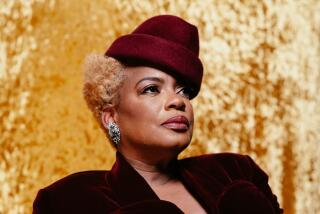A New Family Bible : What happens to those left behind when members of a black family ‘pass’ for white? A daughter reveals the pain.
- Share via
With a simple infinitive-- to be --she was.
For three-quarters of a century, Grace Morris Cramer lived her quiet, Spartan life as a white woman. Her younger sister, Margaret Morris Taylor, cut off from most of the Morris clan, lived as black, worlds apart, haunted by their ghosts.
The story of these two sisters, their torn family and the geography of pain separating them is at the center of Shirlee Taylor Haizlip’s book, “The Sweeter the Juice.” Ostensibly a family biography, Haizlip’s slim volume also examines the facile labels of race and identity, while exploring the varying degrees of privilege. (Haizlip is Margaret’s daughter.)
Passing is a term out of an antique void. It renders the notion of “color” a state of mind. With a slight change of a last name, a new address, a “new race,” some black families splintered in two or three like a branch inflicted with dry rot. The most complex challenge: making sure no clues were left on the trail.
In the case of Margaret Morris, it meant, without warning, that she was unceremoniously relieved of her history. No family Bibles or albums filled to spilling with stoic portraits of her forebears. No grandmother’s hug or grandfather’s knee.
The Washington, D.C., family unraveled in 1916 when Margaret’s mother died and her father and five older siblings scattered to live as whites. Four-year-old Margaret, quite fair-skinned herself, was sent to live with a cousin.
She, too, became what she believed herself to be: a “colored” woman.
Nowadays, Shirlee Haizlip’s sunny Hollywood living room is shot through with photos--six generations of them. Portraits of the family--immediate as well as extended, both black and white--reconstructed through a bridge she built through time.
Margaret Morris Taylor sits beneath a wall of windows, surrounded by the faces that in life had eluded her. Taylor, who has been accompanying her daughter on the book tour, touches on just a small portion of her arduous journey; her reluctance to reach out to the family that had abandoned her as a child: “I wasn’t going to try again,” she says. “They had already rejected me two times. I couldn’t do it again. So Shirlee said she would. . . .”
*
Question: What was your emotional state while revisiting the sources of your mother’s pain?
Haizlip: I’d heard my mother’s story since I was a child, so I think probably the emotionalism was gone . . . . It was just a fact of life. . . . So it was an intellectual exercise to find the answers to this puzzle.
Q: At what point did you decide to turn this search for your mother’s only surviving sister into a book?
A: I didn’t know it was going to be a book. I was doing a personal “This Is Your Life” kind of manuscript for my mother’s 80th birthday. Then I saw the drama of all the things that had happened to her. I thought, “This could be a book.”
I was reading some of the things that I had written at her birthday party and even the waitresses were responding. . . . I have a friend who is an agent, Faith Childs, and I told her I had an idea. . . . The proposal (was) basically what I had already written, just spruced up a little and I sent it to her.
She took it to 10 publishers. And the only one who didn’t offer was Disney Books . Q: For what is often an emotionally fraught topic, to what do you attribute the wide interest?
A: The climate. The mass consciousness. Five years ago, a story like this couldn’t be published. This whole thing about multiculturalism . And diversity statistics have shown that America is getting more and more brown. . . .
In the year 1995, 58% of the world’s women will be Asian. And the fastest-growing group of children in this country are children of mixed race. . . . So the browning of America is inevitable. Corporations have known it, schools know it. And I think it’s just getting out there in the consciousness .
*
But no matter how open or forward-thinking one believes he or she is, what Haizlip contends is sure to raise eyebrows, if not ire, in some quarters. In others, she hopes it mines long-buried issues at the core of race relations.
“Many Americans,” Haizlip writes, “are not who they think they are; hundreds of thousands of white people in America are not ‘white.’ . . . If a new sociological method of determining race were devised, equal numbers of black people might no longer be black. What happened in my family and many others like it calls into question the concept of color as a means of self-definition.”
When he lost his young wife, Rose, to cancer, Haizlip’s grandfather, William Morris Sr. (whom Haizlip describes as being of Irish and mulatto descent) took the first step over the line. Figuratively shedding his skin, he hoped to find better fortune as a “white” man.
Some Morris children were soon to follow. One by one, the siblings sampled life on the other side, breaking ties with the youngest, Margaret and Michael. Only those family members who could pass for white could enter their carefully tended world, the rest were disappeared from the conversation, erased, as best they could be, from memory.
Margaret weathered the abrupt abandonment and the subsequent family rebuffs to “those black genes.” She survived her “own personal middle passage,” Haizlip says.
Margaret eventually married Julian Taylor, a preacher, and they raised four children while he ministered to congregations on the East Coast. He provided a wealth of love and benevolence, Haizlip says. “(My father) was a very strong family man and it was the strength of him that’s wrapped around her.”
Q: What about the book’s reception has most surprised you?
A: I thought it would touch a lot of chords, and it has, but it has gone beyond race. Chords about abandonment . . . the reunification of family . . . class issues, women’s issues. . . .
A woman wrote to me saying she just found out that she was Jewish and how angry she was with her mother for keeping her heritage from her. . . . White people are phoning me . . . and they start the conversations like this: “ I’m white . . . I think. “ I think! It’s a new day in America, when a white person says that.
Q: Were you concerned that some people might misread your intent as an obsession about white blood?
A: Early on, I do the disclaimer that I’m not lusting after my whiteness. There was nothing better in my life than being black. That’s all I knew. . . If you look at the amount of space given to the white family as compared to the black family, it’s the same. OK, you say, but finding the white relatives is the dramatic arc of the story . That’s true, but I say, just being black in America is drama enough. And for a black family to have survived so well, that is high drama.
What amazes me is that no negative response has been articulated . . . because this is not an issue that all black people are thrilled about . . . . What happens is that people get so engrossed in the search for family that it transcends race. And I make the point that we are looking for family that happen to be white, that we didn’t need that whiteness to validate us. And that issue touches people. It melts away . . . any possible hostility.
*
Tracing an elusive trail--with the help of census tracts, random phone calls and even a private detective--she finally struck gold, locating Grace in, of all places, Anaheim. “How appropriate, I thought,” Haizlip writes, “that she should be located near Disneyland, the world of make-believe.”
How this frail woman, now near 90, and the families who had been living as white would respond was impossible to predict. “Should I,” Haizlip wondered, “visit their parents’ sins upon them?”
Q: How did the white half of your family react when you informed them that you were writing a book, that the “secret” would be made public?
A: I didn’t tell them all . . . because I didn’t want a lot of “Well, what are you going to say?” . . . But before the book came out, I put together a very thoughtful memorandum that said I had been working on a book and what it was going to be about. I said . . . some of it may be painful, but I hoped that some of it may be helpful.
So far their response has been very positive . . . . Some parts I think have been more difficult. The difficult parts have mostly to do with people who are dead, so I think that is easier.
Q: But how are those “white” relatives adjusting to being “black”?
A: One (who) was pretty removed from it found it pretty exciting . . . because she has a young person’s view of multiculturalism. . . . She had been working as an au pair in San Diego, so when she told (the couple) how excited she was , the man said to her, “Oh, now you’re a nigger.” This is a woman who grew up believing she was white. There was no reason to think otherwise. . . . I asked her how she was dealing with that, and she said that she’s still processing it.
I like to say that the book deals with two American themes: The American nightmare--the white person waking up and finding that they are black -- and the American fantasy -- black people wondering what it is like to walk around with white skin.
Q: You write: “My color . . . had allowed me to sit on top of and look over both sides of a high wall that separates the black and the white experience. . . .” What have you learned from that vantage point?
A: It has allowed me to learn how pervasive racism is in America. And it reinforces my personal need and drive to bring up the subject of privilege that white skin has brought and the privilege taken away from black people wherever I can , in ways that are not confrontational, but provocative. . . .
None of us are pure anymore and we never were. . . . We cannot be whole people unless we recognize all parts of ourselves . . . . Know it and be willing to open ourselves up to those parts that we don’t know about. If black people can do that and white people can do that, we can get together--that old-fashioned concept of brotherhood deals with a genetic reality , not a philosophical argument.
More to Read
Sign up for our Book Club newsletter
Get the latest news, events and more from the Los Angeles Times Book Club, and help us get L.A. reading and talking.
You may occasionally receive promotional content from the Los Angeles Times.










